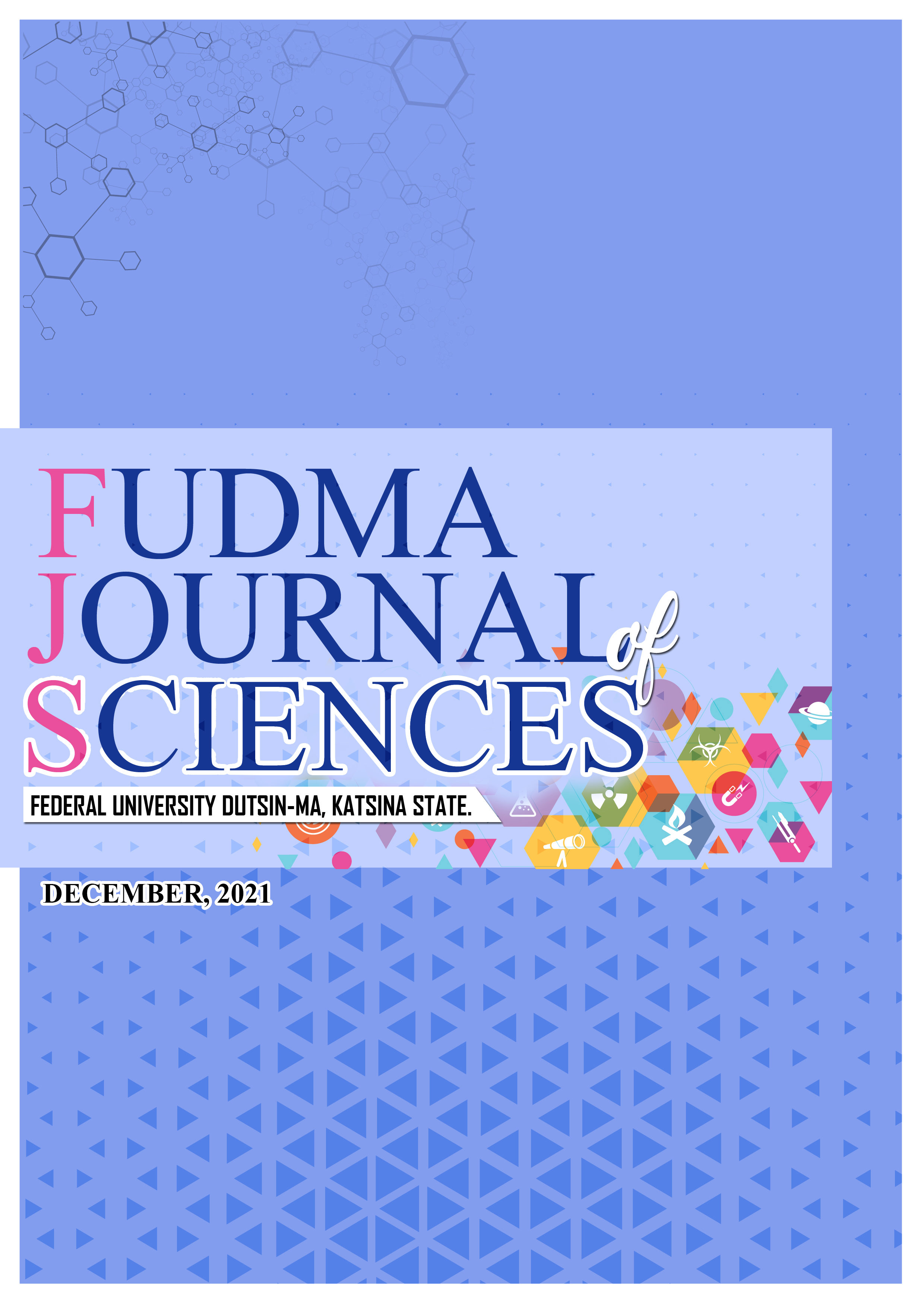PRODUCTION OF BIOGAS FROM CO-DIGESTION OF COW DUNG, CHICKEN DROPPING AND COW RUMEN WASTES
DOI:
https://doi.org/10.33003/fjs-2021-0504-844Keywords:
biodegradable wastes, cow dung, cow rumen wastes, retention periodAbstract
The increased use of fossil fuels for energy consumption has caused environmental problems both locally and globally. This study investigates the anaerobic digestion in the production of biogas, a renewable energy from the digestion and co-digestion of three different types of biodegradable wastes available in Katsina (cow dung, chicken droppings and cow rumen waste) as an alternative for fossil fuels for energy consumption. This was carried out using a 25 Litres capacity plastic keg, constructed to investigate the anaerobic digestion in generating biogas. The experiment was batch operated and the digester was charged with 10 kg of each waste was mixed with 10 kg (10L) of water and loaded into six different batch type biogas plants. Biogas production was measured for a period of 15 days and at an average temperature of 370C. The average biogas production from poultry droppings, cow dung, cow rumen wastes, mixture of cow dung/cow rumen wastes, cow dung/chicken droppings and cow rumen wastes/chicken droppings was found to be 210 cm3/kg, 160 cm3/kg, and 520 cm3/kg, 375cm3/kg, 470 cm3/kg, 390cm3/kg, respectively. During the digestion period, the volume of biogas production and the changes in pH indicate that the pH decreases as the retention period increases. The study recommends that biogas is not just a renewable energy source but also an appropriate way of managing waste, having potential to replace fossil fuel.
References
Amigun, B., and Blottnitz, H., (2007). Investigation of Scale Economies for African Biogas. 48(12):3090-3094.
Aragaw, T., Mebeaselassie, A., and Amare, G., (2013). Co-digestion of Cattle Manure with Organic Kitchen Waste to Increase Biogas Production using Rumen Fluid as Inoculums. 8(11):443-450.
Emmanuel, D., Joseph, D., and Bruno, N., (2015). Operating and Financing a Family Biogas. Journal of energy technology and policies. ISSN: 2224- 3232, 12:1012-1025.
Ezekoye, V. A., and Okeke, C. E., (2006). Design, Construction and Performance Evaluation of Plastic Bio-digester. The Pacific Journal of Science and Technology. 7(2):176-184.
Garba, B., (1996). Mechanism and Biochemistry of Methanogenesis in Biogas Genesis in Biogas Production. Nigerian Journal of Renewable Energy. 7(1&2):12-16.
Garba, M., (2009). Thermal Energy Materials and Optimization for Biomass. PhD Thesis, submitted to the University of Nottingham. 5-7
Green, S., (2009). What is Biodigester? www.greenbeatsolutions.com: http://www.greenbeatsolutions.com. Retrieved 15-10-2015.
Karekezi, S., (2002). Renewables in Africa Meeting the Energy Needs of the Poor. Energy Policy. 30(11&12):1059-1069.
Khandelwal K. C., and Mahdi, S. S., (1990). “A Frame Work for the Financial Evaluation of Household Biogas. 23(1)39-53
Ofoefule, A. U., Nwankwo, J. I., and Ibeto, C. N., (2010). Biogas Production from Paper Waste and its Blend with Cow Dung. Advances in Applied Science Research. 2:1-8. ISSN: 0976-8610.
Ofoefule, A., U., and Onukwuli, D., (2010). “Biogas Production from Blends of Bambara Nut Chaff with some Animal and Plant Wastesâ€. Advanced Applied Science Research 1(3):98-105.
Oladeji, J. T., Olafemihan, E. O., and Itabiyi. (2016). Anaerobic Digester of cow dung with Rumen Fluid. The Journal of Middle East and North African Science. 2(4):56- 60.
Ugwoke, D. U., and Ekpe, E. O., (2010). Fixed-Dome Biodigester Construction and Determination of Effects of Temperature on the Performance. Global Journal of Science Frontier Research. 10(2):33-40.
Ukpai, P. A., and Nnabuchi, M. N., (2012). Comparative Study of Biogas Production from Cow Dung, Cow Pea and Cassava Peeling using 45 liters Biogas Digester. Advances in Applied Science Research. 3(3):1864-1869. ISSN: 0976-8610.
Umar, G., (2015). Effect of Concentration on Biogas Production Potential Using Abattoir Waster (Rumen Contents) – A Case Study of Katsina Abattoir, Nigeria Proceedings of 18th IRF International Conference, Bengaluru, India, and ISBN: 978-93-85832-43-7
Yadvika, S., Sreekrishnan, T., Kohl, R. S., and Rana, V., (2004). Bio-resource Technology. (95):1-10.
Ziana Ziauddin, and Rajesh P “Production and Analysis of Biogas from Kitchen Waste†International Research Journal of Engineering and Technology (IRJET) e-ISSN: 2395 -0056 Volume: 02 Issue: 04 2015.





